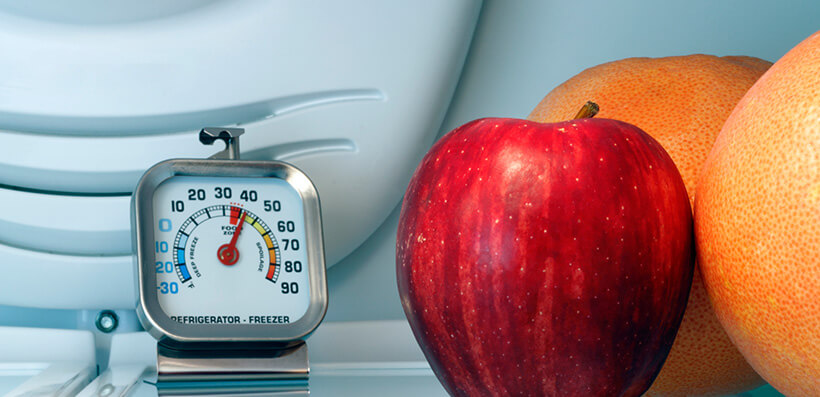
Why Won’t My Fridge Get Cold? – 6 Things You Should Check
July 14, 2015 | Kitchen Appliances Repair, Help & Advice | No comments
Your fridge is one of the most important appliances in your home. So what would you do if your fridge developed a fault, such as no longer reaching the cold temperatures you expect it to?
If you’ve answered purchase a new fridge, you’re wrong! Instead, you should (attempt to) repair the fault yourself, by checking the 6 components mentioned below.
Incorrect Temperature Setting:
On either the internal wall or top of your fridge you’ll find the temperature control, which allows you to set how cool your fridge is. If your fridge is not as cold as you’d like it to be, it could be that this has been knocked when getting something out or putting something into your fridge. Adjusting this should result in your fridge once again reaching the desired temperature.
However, if the temperature setting has not been adjusted there may be a fault with the fridge thermostat – and it is possible the part will need replacing. This can be done by following the steps below (once your fridge is turned off and unplugged)…
- Access the thermostat by removing the temperate control knob, followed by the cover. Once these have been removed, you’ll see the shaft of the thermostat.
- Loosen the nut connected to the thermostat’s shaft, before removing the screw-hole bung followed by the screw behind it.
- Pull the assembly off the wall to gain access to the cover of the thermostat. This will need to be removed from both the top and bottom before you can push the thermostat out of its position.
- Disconnect the wires from the thermostat – although we recommend before doing this you take a picture of the wires, so you know how they’re connected. You should also be careful as some of the connectors may have barbs on them which require you to push down with a screwdriver to release them.
- Remove the capillary from the wall, followed by the sleeve (if fitted) from the capillary.
- Unwind the new fridge thermostat and if previously removed place the sleeve over the top, before gently feeding the capillary back into the fridge and reconnecting it.
To see how easy it is to replace the fridge thermostat, watch our video below.
Dirty Coils:
The coils on your fridge should be cleaned roughly every 6 months, to remove dust and other debris from building up and impacting on their performance. Dirty coils can also result in the fridge motor having to work harder to keep your fridge cold.
Cleaning the coils is a straightforward job, which should only take a matter of minutes, but will make all the difference in both the performance of your appliance and keep your utility bills down.
To clean the coils on your fridge, simply unplug the fridge and move it out so you have access to the coils. Then use a vacuum cleaner or duster to remove any debris, being careful not to bend or put too much pressure on the coils, as this could result in damage. Once your coils have been cleaned, push the fridge back into position and plug it in.
Blocked Air Vents:
A fridge which is too full or is badly stocked can result in food / jars / bottles blocking the air vents, which prevents the air from circulating correctly and stops the fridge from getting cool. Rectify this by carefully placing your produce in your fridge – as per the advice in our previous post “3 Ways to Clean Your Fridge on Clean Out Your Fridge Day” – it’s also recommended to make sure food / jars aren’t touching the back or sides of your fridge.
Damaged Door Seal:
Your fridge door seal may not be a component which you pay particular attention to, but it is one which can have an impact on the performance of your fridge. If the seal is in any way damaged, from being split and cracked or coming away from the appliance then the temperature in the appliance will be impacted.
Thankfully replacing the fridge door seal, whether it is glued on and needs to be cut off or is pushed in, is usually not a difficult task and can be done in a matter of minutes. The latter type of door seal can be replaced by following these steps:
- Pull your damaged seal away from the fridge by starting in one corner and running your thumb underneath it, so it comes away in one go.
- Give the area where the seal once was a thorough clean, using a specialist fridge cleaner.
- Fit the new seal. To do this, you’ll need to start in a top corner, working your way around the door and pressing the seal into place. It’s recommended to press quite firmly to ensure the seal is securely in place.
You can see how easy it is to fit a fridge door seal by watching the video below.
Incorrect Fridge Placement:
Ideally your fridge should have an inch of space between it and any walls / cupboards which surround it, as this will enable the air to circulate correctly and help ensure the coils at the back of your fridge do not overheat.
It is also highly recommended to make sure your fridge is not placed in line with direct sunlight or close to your cooker, as the heat provided will cause your appliance to work harder to stay cool. This in turn can result in faults developing or the appliance not being able to maintain its desired temperature.
Should your fridge be placed too close to the wall, we recommend you move it out to ensure it has the inch gap all the way around, and whilst you’re moving it out you should take the time to give the coils a clean – as per the advice above.
Faulty Compressor:
Nine times out of ten, the reason your fridge is failing to get cold will be due to one of the reasons mentioned above. But from time to time, the compressor could be the cause of the fault – and this is often obvious due to an audible clicking from the fridge.
The two common reasons your compressor is preventing your fridge from getting cold is because it is overheating or not getting the proper power to it and won’t start. If there’s a fault with the compressor which means it isn’t starting but is getting hot, it’s likely the part will need replacing and we would recommend you contact a qualified fridge engineer to carry out such a repair.
Taking the time to check these 6 components, locate the fault and repair it yourself will not only help you bring your fridge back to its original condition, but it will also save you money in both the short and long term.
Tags: Fridge Door Seal, Fridge Temperature, Fridge Thermostat

